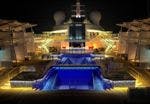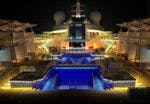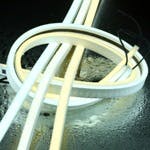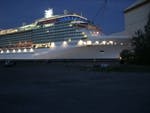This article was published in the July/August 2011 issue of LEDs Magazine.
View the Table of Contents and download the PDF file of the complete July/August 2011 issue.
+++++
In modern cruise ships, lighting systems account for up to 25% of the total energy consumption which is not used for propulsion. This means that any reduction in electricity consumption for lighting leads to a positive impact on the ship’s operating costs, as well as reducing the environmental impact. Lighting providers such as LED Linear, Bluleu LED Solutions and Navalimpianti are already working with leading shipyards throughout Europe to develop efficient LED lighting solutions for cruise ships, including the giant Celebrity Equinox.
Demanding applications
In the shipping business, there are strict and demanding requirements when it comes to lighting. These include color rendering index (CRI) values of at least 80, light/color homogeneity, efficacy of at least 60 lm/W, warm white light of 3000K or less, and a long service life. Excellent weather resistance is also required, particularly for outdoor lighting. In addition, easy assembly and replaceability are required as well as standard sizing, in order to meet relevant standards and regulations.
High color homogeneity is extremely important, particularly for the illumination of long axes of vision, for example along railings, or to illuminate large rooms with several thousand built-in lights. A deviation of only a few Kelvin can be perceived by the human eye as a color difference which is not acceptable, particularly in area or strip lighting.
Light quality and efficiency are two sides of the same coin. For customers, high CRI values together with high efficiency and a warm color temperature are fundamental criteria for the selection of LEDs. However, this is a challenge for LED manufacturers, since high CRI values, combined with a warm color temperature, reduce the efficiency of the lamps.
The service life of LEDs is another important factor for customers, and is influenced heavily by the operating and ambient temperatures. Optimum heat management for LED lights can save costs by drastically extending the service intervals for difficult-to-access lighting solutions.
Celebrity Equinox
Built by the Meyer shipyard, the Celebrity Equinox (Figs. 1 & 3) is a 315m-long luxury cruise liner for 2,500 passengers that is designed to be particularly environmentally friendly. As well as photovoltaic installations, the ship features LED lighting solutions from LED Linear (www.led-linear.com) and Bluleu LED Solutions (www.bluleu.de). The use of LEDs for lighting enables weight savings of up to 30%, which means the overall weight can be reduced by up to eight tonnes. For a cruise ship with 50,000 light sources, the use of LED solutions can allow a reduction of CO₂ emissions of up to 3,000 tonnes per year and an annual cost saving of up to EUR 200,000.
The illuminants used by LED Linear include SAE and Double Dome LEDs from Sharp, mounted on thermally-enhanced flexible circuit boards that are easy to install and can be laid in any shape. With a power consumption of just 7.6 W/m at a supply voltage of 24V, they achieve a luminous efficiency of 75 lm/W for a length of up to 7.5m.
Navalimpianti and Powergiant 2
Another lighting supplier, Italy-based Navalimpianti (www.navim.com), has developed the Powergiant 2 range of recessed luminaires for lighting the interior of vessels. Based on Sharp Zenigata LEDs, these products can directly replace conventional lighting systems and thus can provide an enormous savings potential for existing ships.
A typical cruise ship for 2,800 passengers weighing 92,000 tonnes, with 16 decks and 1,150 cabins, is illuminated in public areas (lobbies, restaurants etc) with just under 8,000 halogen lamps. About one fifth have an output of 35W, while the output of most of the rest lies in the region of 50W – all in all around 370 kW for the public areas alone.
Thanks to the service life of 50,000 hours, further savings are possible due to lower maintenance costs. With an average use of 10 hours a day, a Powergiant 2 will remain operational for over eight years until it has lost 30% of its initial brightness. The service life of a high-quality halogen lamp is only 6 to 7 months. Usually the service life of halogen lamps is even lower due to the vibrations when the engines are running, while this strain does not affect LED technology.
The Powergiant 2 LED recessed luminaires ensure very natural color rendering of illuminated objects with a CRI value of 80. The light output is 60 lm/W with a power consumption of just 9W. This leads to a very low surface temperature compared to halogen lamps, drastically reducing the risk of fire on board.
Powergiant2 lights are dimmable and fully compatible with the Helvar Lighting dimming system or other IGBT phase-cut dimmers, which are often used on ships. As a result, Powergiant products can replace existing halogen solutions without the need for extensive changes to cabling and electric circuitry.
LED supplier requirements
The high demands placed by shipbuilders on their lighting suppliers explain why companies such as LED Linear and Navalimpianti attach great importance to quality in the selection of LEDs.
Homogeneity is a great challenge in LED production, requiring a defined color temperature which is as uniform as possible in each component, in all production batches. Many manufacturers accept a certain fluctuation margin in LED production and subsequently place the LEDs into different bins in accordance with defined deviations from the original color. Sharp, on the other hand, has already optimized the manufacturing process of its LED arrays so that the fluctuation margin of the color temperature is so small that it cannot be perceived by the human eye. LEDs from one series can hardly be distinguished from one another optically, even if they come from different production batches.A second important selection criterion is CRI. Sharp uses different mixtures of red and green phosphor, so that all its white LED components, for all color temperatures, have a CRI value of at least 80. The Zenigata and Mega Zenigata series have a CRI value as high as 94.
The third important criterion for shipbuilders is long service life which, in the case of LEDs, depends on how efficiently the heat can be dissipated. As an LED substrate, Sharp uses a ceramic plate with silicone sealing instead of conventional plastic materials. This design allows for efficient and homogeneous heat dissipation as well as good thermal and mechanical resistance. This helps to keep the required cooling element small, but also to guarantee the service life of 50,000 hours (at a substrate temperature of up to 80°C, depending on the module). These concerns were a further reason why LED Linear and Navalimpianti chose Sharp as a strategic partner for the supply of LED components.








